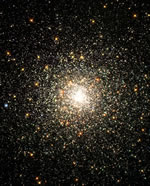
Image credit: Hubble
Thousands of globular star clusters wander aimlessly between galaxies, in what was once thought to be ’empty space’. This is the finding of a joint US-UK project announced today at the International Astronomical Union General Assembly in Sydney. The group, lead by Dr. Michael West of the University of Hawaii, believes these clusters were ‘torn’ away from their parent galaxies and now drift as orphans. (contributed by Darren Osborne)
US and UK astronomers have discovered a population of previously unknown star clusters in what was thought to be the empty space between galaxies. The research is being presented today at the International Astronomical Union?s 25th General Assembly being held in Sydney, Australia, by Dr. Michael West of the University of Hawaii.
Most galaxies are surrounded by tens, hundreds or even thousands of ancient star clusters, which swarm around them like bees around a hive. Our own Milky Way galaxy has about 150 of these ?globular clusters?, as they are called. Globular clusters are systems of up to a million stars compacted together by gravity into dense sphere-shaped groupings. Studies of globular clusters have provided many important insights over the years into the formation of their parent galaxies.
The discovery of this new type of star cluster was made using images obtained last year with the Hubble Space Telescope and the giant 10-meter Keck Telescope on Mauna Kea, Hawaii. ?We found a large number of ?orphaned? globular clusters,? said Dr West. ?These clusters are no longer held within the gravitational grip of galaxies, and seem to be wandering freely through intergalactic space like cosmic vagabonds.?
Although the lonely existence of such star clusters had been predicted for half a century, it is only now that astronomers have finally been able to confirm their existence. Dr West?s team published preliminary findings about its discovery in April this year, and is today presenting new results at the International Astronomical Union?s 25th General Assembly, being held in Sydney, Australia.
?The new data from the Hubble Space Telescope and Keck Telescope confirm our discovery, and are providing new insights to the origin of these objects,? said Dr West.
According to West, these globular star clusters probably once resided in galaxies just like most of the normal globular clusters that we see in nearby galaxies today. However, the pull of gravity from a passing galaxy can rip stars and star clusters loose — in some cases entire galaxies can be damaged or destroyed by violent collisions or by the collective gravitational pull from their galactic neighbors.
It is thought that the partial or complete destruction of their parent galaxies spilled the globular star clusters into intergalactic space.
Finding these globular clusters hasn?t been easy. With only one exception, all of the intergalactic globular clusters the teams have detected are so far away (millions of light-years) that they just look like tiny points of light in a vast sea of blackness.
?Because they’re so far away these objects are very faint, almost a billion times fainter than the unaided human eye can see,? said Dr West. ?Detecting such faint objects pushes the limits of even what the Hubble Space Telescope can do.?
?By studying these intergalactic vagabonds in greater detail we hope to learn more about the numbers and types of galaxies that may have been destroyed so far during the life of the universe,? said Dr West. ?Some of these star clusters might also eventually be ?adopted? by other galaxies if they stray close enough to be captured by their gravity.?
The researchers are currently analyzing new Hubble Space Telescope images they recently obtained, and are planning to obtain more at the end of this year.
Original Source: University of Hawaii News Release
